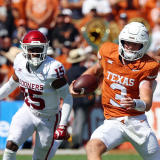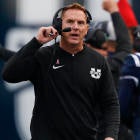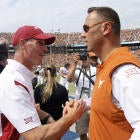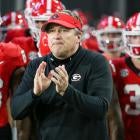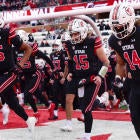Matt Dudek wants to be an NFL general manager one day. Why, then, put up with the pretense of his title at Arizona -- director of on-campus recruiting and player personnel?
"I joked about it, like, four years ago in the staff room," Dudek recalled. "'Coach, if you want to make me a GM, that's great.' Everybody laughed."
Not anymore. In an age when college football staff sizes are exploding, Dudek is an original. In fact, former Cleveland Browns GM Phil Savage called him just that -- college football's first general manager.
Dudek is responsible for everything from recruiting to roster management to being the NFL liaison and the face of the program. On National Signing Day, he is up three hours before the 7 a.m. MT start of the school's streaming announcement show to pluck letters of intent off the fax.
"I bounce back and forth from so many different things," said Dudek, a 35-year-old father of three. "I can see myself being an AD. I can see myself being a GM in the NFL."
He is not alone. College administrators as a whole are wrestling with the exploding size and worthiness of football staffs. The NCAA Football Oversight Committee is expected to take a deep dive into the subject in the next year.
For now, there is proposed legislation to expand the number of full-time coaches from nine to 10. The subject will be addressed this week at the NCAA Convention. But that doesn't begin to dig into the phenomenon of what has become basically unlimited off-field personnel.
There are small countries with fewer governmental officials than some Power Five staffs. One source said Alabama has at least 21 persons tied directly to football beyond Nick Saban and his nine full-time assistants. Two of them last season were former head coaches in Steve Sarkisian and Mike Locksley.
Strength coaches are arguably a coach's most valuable members of the staff. They can interact with players during a time in the offseason when the regular coaching staff can't.
What's to keep any strength coach from running scripted plays with players in shorts and shirts during the summer? Who's going to know?
Is that a competitive advantage? Should any staff be limited in size? The NCAA's track record on such issues isn't good. Almost 18 years ago, it lost a landmark antitrust lawsuit over restricted earnings for coaches that cost the association almost $60 million.
Whatever the case, it's clear the money schools earn from the College Football Playoff and network rights fees is being plowed right back into football from whence it came.
Sarkisian went from making $28,000 as analyst to a six-figure offensive coordinator a week before the CFP National Championship. His predecessor, Lane Kiffin, got a $720,000 raise last year when his USC buyout ran out.
The tap isn't going to be shut off anytime soon. In the Big 12 alone, schools will be making $40 million each annually from rights fees alone by the end of the current contract in 2024-25.
"We're a failed business model by nature," said one prominent Power Five athletic director. "If you have 20 shampoo products and two make money, it doesn't make sense.
"[Football] makes so much money for the institution. You still got to support 19 other sports. ... You continue to feed the goose. We're not the pro model.
"Once you start depleting and investing in that goose that lays the golden egg, [you're in trouble]."
Given all of that, it's easy to see why the likes of Billy Devaney have emerged at Nebraska. Devaney, 61, actually was an NFL general manager (St. Louis Rams, 2008-11).
He spent 21 years overall in the NFL until being hired last year by old friend Mike Riley as executive director of player personnel.
The veteran NFL front office guy suddenly went to grading high-school film.
"You're talking about 15-, 16-year-old kids, [projecting] how big they're going to be," Devaney said. "They haven't even gone through their growth spurts.
"It's hard trying to figure out level of competition. You put a highlight tape and see these big offensive linemen knocking kids down with one hand -- and they're 160 pounds."
Devaney's only college experience was scouting players on campus. He fondly recalled meeting Nebraska icon Bob Devaney (no relation) more than 20 years ago.
"I went to the Bob Devaney athletic complex, took a picture and cropped out the 'Bob' part," Billy Devaney said. "I sent it to my dad for Father's Day. I said, 'Things are going well. They named a building after me.'"
Devaney describes himself as "executive director, basically, of football." That fits the description of Alex Hammond, who calls himself West Virginia's "chief of staff."
Anything that isn't on-field football can be handled by Hammond, 35, who basically takes it off the plate of coach Dana Holgorsen. His technical title -- associate athletic director -- hides the fact he has a law degree from Northwestern and worked at the NCAA as associate director of amateur certification.
"I loved the legal training, being able to synthesize it down to exactly what you need to know. I think that translates what we do in the football world," Hammond said.
The race to get that perfect "GM" is on. Former Texas coach Mack Brown once complained about the proliferation of staffers at Alabama. Then he hired Patrick Suddes from Bama as his director of player personnel. Suddes has since moved on to Arizona State and Auburn.
Do your job at a high enough level and that NFL GM job isn't so far fetched. If you can evaluate talent at the college level, you can do it at the next level.
"Any opportunity is a good opportunity," Dudek said. "Interns all want to get into recruiting. You take any job you can get. I took a job as a video guy and hung around."
That Power Five AD concluded, "Some are calling them player personnel, analysts. Some call them general mangers.
"I don't know where it's all going. I just know that, at the end of the day, football is such a critical component, conference shifts -- all that -- none of it was done because of basketball."
NFL disappointment ahead: Monday was the deadline for underclassmen to declare for April's draft. It turns out that some of them still don't get the message. Ninety-five underclassmen have either declared or intended to declare, according to NFL.com.
Simple math alone should tell you a lot of guys have made bad decisions. If all 95 were drafted, they would account for approximately 38 percent of the 250 draft slots.
Not only is that not happening, in all likelihood it will be the opposite. Since 2014, approximately one-third of the underclassmen that have declared (a total of 90) were not drafted.
In 2014, a record 37 percent (36 of 98) went undrafted. That marked the fourth consecutive year a record number of underclassmen had come out. It seems little has changed since I wrote about the underlying causes of the crisis in 2015.
Short gains: The 2017 season may start the way 2016 ended. No. 2 Clemson beat No. 1 Alabama last week. Likely No. 1 Bama will open 2017 against possible No. 2 Florida State in the Chick-fil-A Kickoff Game on Sept. 2 in Atlanta ... A GoFundMe page exists for Armed Forces Merit Award winner Steven Rhodes of Middle Tennessee. Rhodes is the Marine the NCAA attempted to ban because he played in a recreational league while in Europe. Please donate if you can. Rhodes, a father of two, needs the money to fund his combine prep ... So Texas' Tom Herman is inexperienced? Six of the last nine Texas coaches have come to the job with three years' head coaching experience or less. That includes one Darrell Royal. Herman spent two years at Houston.


